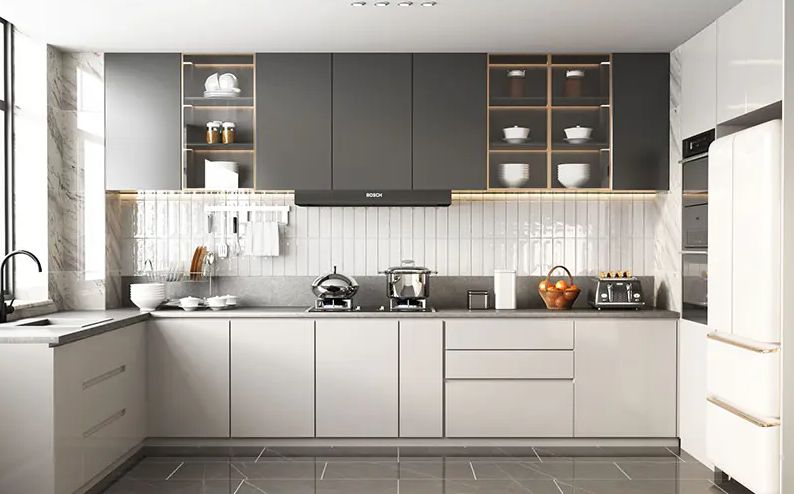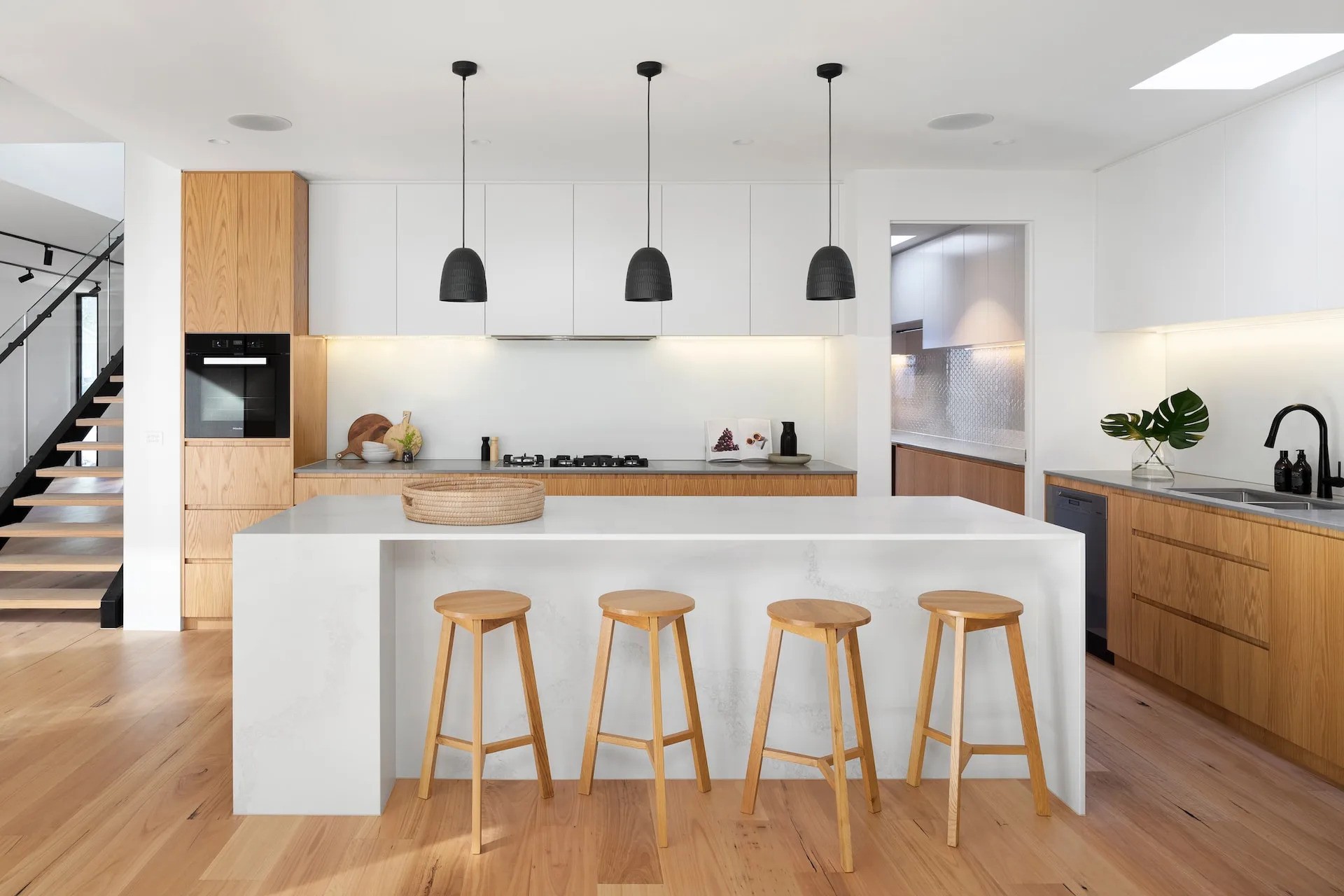In the world of cabinetry, surface finishing is not merely a protective measure—it is the final touch that defines style, durability, and long-term value. Whether you are designing a kitchen, wardrobe, or office storage, the choice of finish influences not only the look but also the feel and maintenance requirements of the furniture. At Custom Cabinet Factory, we understand that a cabinet’s surface is the bridge between its structural integrity and its visual appeal. From glossy lacquers to textured laminates, each finish carries unique benefits, design possibilities, and performance characteristics.
1. Lacquer Finishes
Lacquer is a high-quality, spray-applied coating that cures into a smooth, hard, and often glossy surface. It is prized for its seamless appearance and the richness of its color options, making it ideal for modern, high-end interiors. One of its key advantages is the depth and vibrancy it gives to colors, whether in high gloss, matte, or satin finishes. Lacquered cabinets are also resistant to moisture and relatively easy to clean. However, they require careful handling during installation, as the surface can be prone to scratching and chipping if impacted.

Designing with lacquer often involves selecting bold, uniform tones for a sleek, contemporary look, or soft neutral shades to create understated elegance. Popular trends include deep jewel tones, minimalist white gloss, and muted matte shades for a sophisticated, velvety effect. In one notable kitchen project, a deep navy lacquer finish was paired with brass handles and integrated LED lighting, creating a striking focal point that combined modern precision with luxurious warmth.
2. Wood Veneer Finishes
Wood veneer is a thin slice of natural wood adhered to a substrate, allowing for the warmth and beauty of real wood without the cost and weight of solid timber. Veneer offers a more natural and tactile experience compared to synthetic finishes, showcasing authentic grain patterns that bring character and depth to cabinetry.
Advantages include:
-
A premium and authentic visual appeal
-
Lighter weight compared to solid wood
-
The ability to stain or refinish over time
Drawbacks:
-
Sensitivity to moisture
-
Susceptibility to scratches
-
Best suited for dry, low-impact environments
Designers often use wood veneer to add warmth to modern interiors or to bring organic texture into minimalist spaces. Current trends lean toward rift-cut oak and walnut for clean, linear grain patterns, as well as mixed-material compositions where veneer is combined with lacquer or metal. A living room project demonstrated veneer’s potential when a wall-length cabinet used walnut veneer in horizontal grain, paired with matte black open shelving, achieving both visual rhythm and inviting texture.
3. PVC Film Finishes
PVC film, also known as thermofoil, is a flexible vinyl layer heat-pressed onto MDF or other substrates, creating a smooth and continuous surface. It offers a wide variety of colors, patterns, and even realistic wood textures, making it an affordable alternative to more expensive finishes. Its strengths lie in its moisture resistance, ease of cleaning, and cost-effectiveness. However, PVC film can be vulnerable to peeling or warping if exposed to high heat, so placement near ovens or direct sunlight should be planned carefully.
In design, PVC film finishes are often chosen for their adaptability. They can mimic high-gloss lacquer, natural wood grain, or textured surfaces without the higher maintenance requirements of the originals. Trends include matte PVC films with anti-fingerprint properties, as well as dual-tone cabinet fronts where PVC finishes contrast with natural wood accents. A small apartment kitchen showcased PVC’s potential with soft grey matte doors accented by oak-look PVC open shelves, creating a cohesive yet affordable aesthetic.
4. Fireproof Board Finishes
Fireproof board, often made of high-pressure laminate (HPL) bonded to a fire-retardant core, is designed for durability and safety. It is a top choice in commercial settings, high-traffic kitchens, and spaces where fire resistance is a priority. This material resists heat, scratches, moisture, and impact, making it highly practical. While it lacks the seamless appearance of lacquer, it compensates with long-term resilience and easy maintenance.
Key Features of Fireproof Board Finishes
| Aspect | Details |
|---|---|
| Core Material | Fire-retardant substrate with HPL surface |
| Durability | Highly resistant to heat, moisture, scratches, and impact |
| Aesthetics | Wide range of colors, stone effects, and metal-look surfaces |
| Best Use | Commercial kitchens, hospitality venues, high-traffic areas |
| Maintenance | Easy to clean, retains appearance over time |
| Drawback | Lacks the seamless, high-gloss look of lacquer |
Design-wise, fireproof board finishes are available in a broad range of colors and patterns, from solid tones to stone and metal effects. Modern trends include industrial concrete-look laminates for loft-style kitchens, and bright, playful colors for educational or hospitality environments. In a high-volume restaurant kitchen, a combination of stainless-steel countertops and fireproof board cabinet fronts in a slate-grey finish provided a professional-grade workspace that balanced safety, function, and style.
5. Melamine Finishes
Melamine is created by bonding a printed decorative paper to a particleboard or MDF core under heat and pressure. It is one of the cost-effective and widely used finishes, offering an extensive range of designs—from plain colors to highly detailed wood and stone patterns. Melamine surfaces are hard, scratch-resistant, and easy to clean, making them suitable for both residential and commercial applications. However, the exposed edges must be properly sealed to prevent moisture penetration.
In design, melamine excels at delivering consistent, repeatable patterns and colors, making it ideal for large-scale projects. Trends favor textured melamine that simulates real wood grain with remarkable accuracy, as well as matte black or white surfaces for sleek, modern interiors. A recent office renovation used light oak-effect melamine cabinets to create a warm, collaborative environment, achieving the look of real wood with minimal cost and maintenance.

Haibo Custom Cabinet Factory
Choosing the right surface finish for your cabinets is a balance between aesthetics, durability, maintenance, and budget. Lacquer delivers unmatched gloss and color richness, wood veneer offers natural beauty, PVC film provides adaptability and affordability, fireproof board ensures resilience and safety, and melamine combines cost-effectiveness with variety. Each finish has its ideal application, and understanding their unique qualities helps ensure that your cabinetry will be both beautiful and practical for years to come.

 English
English русский
русский Français
Français Español
Español bahasa Indonesia
bahasa Indonesia عربى
عربى



